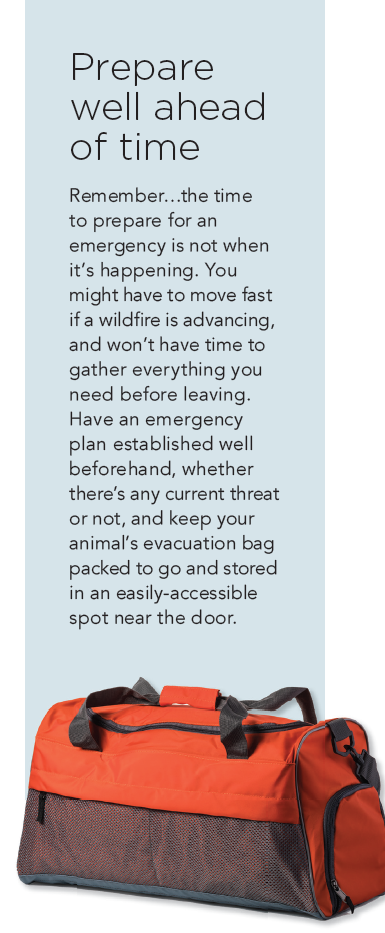Wildfire preparedness for dogs and cats

Thanks to climate change, wildfires are growing more common, widespread and devastating. If you live in or near a region that’s prone to brush fires, it’s vital to have an evacuation plan in place for your animals as well as yourself.
Most of us enjoy summer’s hot, dry, sunny weather. But in some regions of the US and Canada, this great weather comes with a price — the risk of fast-moving wildfires that can devastate both rural and urban areas. And that price seems to be rising every year, thanks to the increase in extreme heat waves and droughts being brought about by climate change. Because brush fires can move so rapidly, especially when it’s windy, an emergency evacuation plan that can be deployed at a moment’s notice can save the lives of your human and animal family. This article covers what you need to know about ensuring your dog or cat stays safe if wildfire threatens – no matter where you live.
Have an emergency evacuation go-bag ready
When it comes to wildfires, there’s nothing more important than being well-prepared and ready to evacuate immediately. “Prepare a go-bag for your animal, with food, water, bowls, any medication, an extra leash and collar with ID tags, and a printed photo of the animal in case of separation,” says Dr. Nicholas H Dodman, BVMS, DVA, DACVAA, DACVB.
Don’t forget to add extra bottles of any supplements he’s taking, along with bedding, and perhaps a piece of your clothing, such as old t-shirt, to help comfort him. To ease anxiety during an evacuation, add a bottle of Bach Rescue Remedy to the bag.

Find a place to stay for both you and your animals
One of the best ways to be prepared for a fire emergency evacuation is to know where you and your animals are going to stay. “It’s crucial to include your furry family members when preparing for disasters and emergencies,” says Matt Myerhoff, Media Information Officer for the City of Malibu, California. “Finding a place to stay that is willing to house both you and your pets can be difficult when demand is high following a disaster.”
Keep in mind that the accommodation needs to be far enough away that it won’t be immediately affected by the fire. See below for suggestions on finding places for your animal to stay.
Make sure your dog or cat has up-to-date ID
Even with a top-notch emergency plan in place, your dog or cat could still get misplaced or lost during a wildfire disaster, so prepare for that eventuality. Microchipping your animal is of utmost importance, as is making sure his collar has an ID tag on it at all times. Ensure that all ID information is kept current. A GPS device for your animal is another option.
“When a disaster is imminent, some people will also write on their pets’ bellies with permanent marker — they clearly label the animal’s name and a phone number,” says Dr. Dodman. “The idea is that when massive volumes of displaced animals are involved, especially if there isn’t access to a microchip database and/or collar slips, there will still be a way to reunite with your dog or cat.”
Brush up on crate and carrier training
Ideally, your dog will accept being crated during an emergency evacuation, but chances are he’ll be just as anxious as you are. The key to having your dog ready for a wildfire emergency is to prepare well ahead of time by brushing up on his crate training.
“Crates may be needed for rapid transportation out of a fire zone,” says Dr. Dodman. “The great thing about crate training is that it’s something you can do now so that your dog is better prepared for the future. Many dogs love their crates. Also on the subject of training, it’s important to make sure your dog responds to his name and has solid recall.”
Cats should also be kept acclimatized to their carriers. Leaving the carrier out with some comfy bedding in it can help a cat come to associate it with something that’s not to be feared.
Wildfire readiness – a summary checklist
The City of Malibu Office of Public Safety offers these steps to help residents include their animals in their family emergency plan:
- Assemble a portable pet disaster supplies kit. It should include medications and medical records, as well as the following:
- First aid kit
- Leashes, harnesses and/or carriers
- Current photos of your animal (digital and hard copy)
- Food, water, bowls, cat litter and litter tray
- Pet beds and toys, if easily transportable
- Have a safe place to take your dog or cat.
- Contact hotels outside your immediate area to check their policies on accepting pets, including restrictions on number, size and species.
- Identify friends or relatives outside your area who can shelter your animals during a wildfire.
- Prepare a list of boarding facilities and veterinarians who could shelter animals in an emergency (include 24-hour numbers)
- Be prepared to house your animals separately.
- Make sure your pet is clearly identified.
- Make sure all dogs and cats are wearing collars with securely-fastened and current identification information.
- You can buy temporary tags or put adhesive tape on the back of your animal’s ID tag, adding information with permanent ink.
If you live in a region that’s prone to brush fires, the best thing you can do is have an evacuation plan ready for both you and your animal companions.




